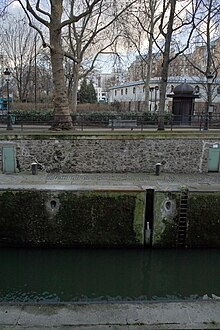Gibet de Montfaucon

The Gibet de Montfaucon , or Falkenberg gallows in French , was the main gallows of the kings of France . It stood at the foot of the Butte de Chaumont hill northeast of medieval Paris near the road to Meaux (the so-called route d'Allemagne ).
The gallows was reserved for those delinquents convicted of crimes against the king and the state. Ordinary criminals were hanged at the nearby Gibet de Montigny .
history

The name Faucon probably goes back to a family Fulco or Faucon (German: falcon) who owned the land there in the 12th century. In 1189 a Robert Faucon sold a piece of the land to the enclos Saint-Lazare .
A gallows at the site was first mentioned in a document in September 1233. In 1274 the poet Adenès wrote about the hanged man in Montfaucon .
The establishment of the great Gibet de Monfaucon is attributed to Enguerrand de Marigny (born around 1260). He was an advisor to King Philip the Fair . De Marigny himself was convicted in 1315 and hanged in Montfaucon .
The gallows, also known as the grande Justice de Paris , rose on a stone pedestal. The cuboid base was two to three toise high (about four to five meters). Behind a lockable gate a stone staircase led to the six to seven Toise long and five to six Toise wide platform (about twelve by ten meters). On top of it were 16 thick, square pillars, 32 or 33 feet high (around ten meters), connected by wooden cross beams. In the middle of the base a cellar was built in which the bones of the hanged men were disposed of.
Between 1440 and 1460 numerous women were buried alive on the Galgenberg . Middle of the 16th century, under King Charles IX. Hung up to 80 Exekutierte simultaneously Gibet .
After the Hôpital Saint-Louis hospital opened a little south of Montfaucon in 1607 , the number of executions fell . The last execution was carried out in 1629, after which the gallows fell into disrepair.
In 1761 the gallows was moved about five hundred meters to the northeast between the municipalities of Belleville and La Villette (near today's Marché Secrétan ). It stood there, unused, as a symbol of the justice royale until its destruction during the French Revolution .
Relics
In 1823, stones from the gallows are said to have been used for parapets in the construction of the nearby Canal Saint-Martin . One of the locks on the canal was named “Lock of the Dead” (Écluse des Morts) .
Remains of the gallows were found in 1954 when a garage was being built. In the 10th arrondissement , rue de la Grange-aux-Belles number 53, near the Place du Colonel Fabien , construction workers excavated old pillars, paving stones and the bones of a woman.
In 1978 a large apartment block was built on the site. The official memorial plaque on rue de la Grange-aux-Belles at the corner of rue des Écluses Saint-Martin names Place Robert Desnos , between the apartment block and the canal, as the location of the old Gibet .
Detail from Grandes Chroniques de France by Jean Fouquet , ca.1460
Famous Executed
- 1278, June 30th: Pierre de la Brosse , favorite and chamberlain of Philip III.
- 1315, April 30th: Enguerrand de Marigny , Treasurer of Philip IV.
- 1322: Gérard de la Guette , Treasurer of Louis X.
- 1323, May 22nd: Jourdain de l'Isle , gentilhomme ; nephew by marriage of Pope John XXII.
- 1328: Pierre de Rémy , Treasurer of Charles IV.
- 1378: Jacques de Rue , Chamberlain to Charles II of Navarre .
- 1378: Pierre du Tertre , Secretary to Charles II of Navarre.
- 1409, October 17th: Jean de Montaigu , surintendant des Finances of Charles VI.
- 1484, May 21: Olivier le Daim , confidante of Louis XI
- 1527, August 12th: Jacques de Beaune, Baron de Semblançay , surintendant des Finances Franz 'I.
- In 1572 the body of Gaspard II. De Coligny , Admiral of France , who was killed and beheaded during St. Bartholomew's Night , was hung by his feet.
Further information
Among those executed were five French finance ministers , four of whom were posthumously rehabilitated.
literature
- Maillard, Firmin: Le gibet de Montfaucon. (Étude sur le vieux Paris). Gibets, échelles, piloris, marques de haute justice, droit d'asile, les fourches patibulaires de Montfaucon. Publisher: A. Aubry, Paris 1863 ( online ).
Web links
Individual evidence
- ^ Maillard, Firmin: Le gibet de Montfaucon. Paris, A. Aubry, 1863. pp. 9ff.
- ^ Maillard, Firmin: Le gibet de Montfaucon. Paris, A. Aubry, 1863. pp. 12f.
- ^ Maillard, Firmin: Le gibet de Montfaucon. Paris, A. Aubry, 1863. p. 39.
- ^ Maillard, Firmin: Le gibet de Montfaucon. Paris, A. Aubry, 1863. p. 15.
- ^ Joanne, Adolphe: Les environs de Paris illustrés: itinéraire descriptif et historique. Paris, 1856. p. 90.
- ↑ Christophe, Jeannine: Quand l'archéologie nous conte. L'histoire du 10e. In: Féraud, Rémi: Les infos du 10e. No.14. Paris. January 2012.
- ↑ http://www.nicolaslefloch.fr/Lieux/Montfaucon.html (accessed January 29, 2012)
Coordinates: 48 ° 52 ′ 40.2 " N , 2 ° 22 ′ 5.1" E



